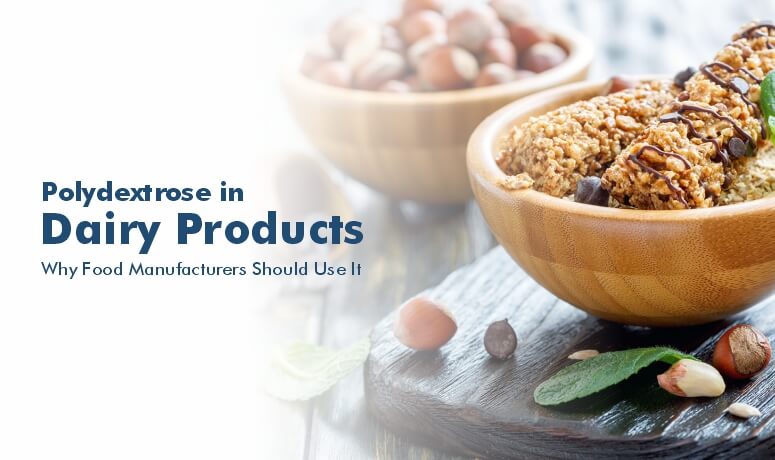The dairy business is always changing because companies are always looking for new ways to improve their products. Polydextrose stands out as a potential ingredient because it has a unique mix of health benefits and useful properties. This blog will discuss details about polydextrose, including its qualities, how it is used in dairy products, and the strong reasons why food companies should consider adding it to their products.
What Exactly is Polydextrose?
Polydextrose is a corn-derived, low-digestible, soluble dietary fiber. It is a type of carbohydrate known as a prebiotic, which stimulates the growth and activity of good bacteria in the stomach. This prebiotic action has several health benefits, making polydextrose a desirable component for health-conscious consumers.
Chemical Composition and Key Properties
The molecules dextrose (glucose), anhydrosorbitol, and citric acid are mixed together to make polydextrose. It has several useful properties for food uses that come from its unique structure:
1. Solubility: Polydextrose dissolves easily in water, making adding to a wide range of dairy products is simple.
2. Low Digestibility: Because polydextrose has a complicated structure, the human digestive system can’t break it down well. This means that it has few calories (about 1 kcal/gram) and doesn’t affect blood sugar levels much.
3. Prebiotic Effects: As we already said, polydextrose is a prebiotic that helps good bacteria like Bifidobacteria and Lactobacilli grow in the gut. These bacteria are good for gut health because they help with digestion, make it easier for the body to absorb nutrients, and boost the immune system.
4. Texturing and Bulking: Polydextrose can both texture and bulk up a product, giving it a creamy taste and helping dairy products have more body.
5. Fat Replacement: Polydextrose can partly replace fat in dairy products, which lowers the number of calories without changing the taste or texture.
6. Increases Shelf Life: The prebiotic properties of polydextrose may help dairy goods last longer by stopping the growth of microorganisms that cause spoilage.
Applications of Polydextrose in Dairy Products
The functional qualities of polydextrose make it useful in a wide range of dairy products. For example, it can add fiber, lower sugar and fat, and improve the texture. You can use polydextrose in a lot of different ways in dairy goods, including the ones below:
1. Yogurt
- Sugar Reduction: Polydextrose helps lower the sugar in food while keeping the sweetness and taste you want.
- Fiber fortification: raises the amount of dietary fiber in a food to improve its nutritional balance.
- Texture Improvement: It makes the texture creamier and stops syneresis (whey separation).
Adding polydextrose significantly improves the water-holding capacity, sensory attributes, and texture properties of yogurt compared to the FFBS control yogurt (P < .05)
2. Ice Cream and Frozen Desserts
- Sugar and Fat Replacement: As a bulking agent, it replaces sugar and fat in foods without changing their taste or structure.
- Better Mouthfeel: Makes the texture smoother and creamier.
- Loss of Calories: This helps lower the product’s total caloric content.
3. Cheese and Cheese Products
- Fat Mimicry: When used in reduced-fat and low-fat cheeses, fat mimicry makes the cheese feel and look like full-fat cheese.
- Better Texture: It gives the cheese more body and stability.
- Fiber Enrichment: This process adds fiber to cheese goods, which don’t normally have fiber.
4. Milk and Milk Beverages
- Fiber Addition: Giving extra fiber to milk is good for people who care about their health.
- Sugar Reduction: This helps lower sugar in flavored milk drinks while keeping their sweetness.
- Caloric Reduction: This helps make milk drinks with fewer calories available.
5. Dairy-Based Sauces and Dressings
- Texture Stabilization: Makes dairy-based soups and dressings thicker and more stable.
- Fat Reduction: It makes it possible to lower the amount of fat while keeping the creamy structure.
6. Dairy-Based Desserts (e.g., Puddings, Custards)
- Sugar Replacement: This helps lower the amount of sugar while keeping the sweetness level the same.
- Texture Enhancement: Helps make the consistency smooth and creamy.
- Fiber fortification: This process adds fiber to desserts.
7. Whipped Toppings and Creams
- Volume and Texture Improvement: Makes whipped goods more stable and gives them more volume.
- Caloric Reduction: It makes making whipped sauces with fewer calories possible by switching out sugar and fat.
8. Buttermilk and Sour Cream
- Texture Enhancement: Makes low-fat or reduced-fat versions thicker and smoother in the mouth.
- Fat Reduction: It takes the place of fat in low-fat recipes to keep the rich, creamy feel.
9. Dairy-Based Nutritional Products (e.g., Shakes, Supplements)
- Fiber Enrichment: This process adds fiber to nutritional drinks and supplements, which makes them healthier.
- Sugar and Calorie Reduction: This helps lower the amount of sugar and calories in the food, making it ideal for diabetic and weight-loss diets.
10. Probiotic Dairy Products
- Prebiotic Function: It works as a prebiotic, which means it helps the growth of good bacteria in the gut when used with probiotics.
- Texture and Stability: It makes probiotic yogurt and other dairy products smoother and more stable.
Benefits for Food Manufacturers
There are several compelling reasons why food manufacturers should use polydextrose in the dairy industry should consider using polydextrose:
- Meeting Consumer Needs: People are becoming more health-conscious and looking for dairy goods that can do more. Polydextrose fits this trend because it has prebiotic benefits and may help you lose weight.
- Differentiation of goods: Manufacturers can make new dairy goods that stand out in the market by adding polydextrose.
- Versatility and Functionality: Polydextrose’s special qualities make it useful in many dairy products because it can add bulk, change the texture of foods, and replace fat.
- Clean Label Appeal: Polydextrose has a simple chemical structure that makes it easy for consumers to recognize. This fits with the move toward clean labels.
- Possibility of Cost Savings: Polydextrose may save money depending on the use because it can add bulk and possibly replace fat.
Important Considerations
While polydextrose has various benefits, some factors must be considered:
1. Compliance with Food Regulations: Make sure that the way you use polydextrose doesn’t break any local or foreign food regulations.
2. Sensory Evaluation: Do full sensory testing to find the best amount of polydextrose to use and make sure the texture and taste are what you want.
3. Consumer Preferences: It’s very important that consumers like the final product. Market research can help you figure out how people feel about dairy goods that contain polydextrose.
The Bottom Line
To sum up, Polydextrose gives dairy manufacturers a special chance to improve their products. Its prebiotic qualities, usefulness, and ability to lower calories align with what people want. By carefully thinking about the uses, benefits, and ways to implement them, food companies can use polydextrose to make new, healthy dairy products.
 info@polydextrose.in
info@polydextrose.in






Leave a Reply